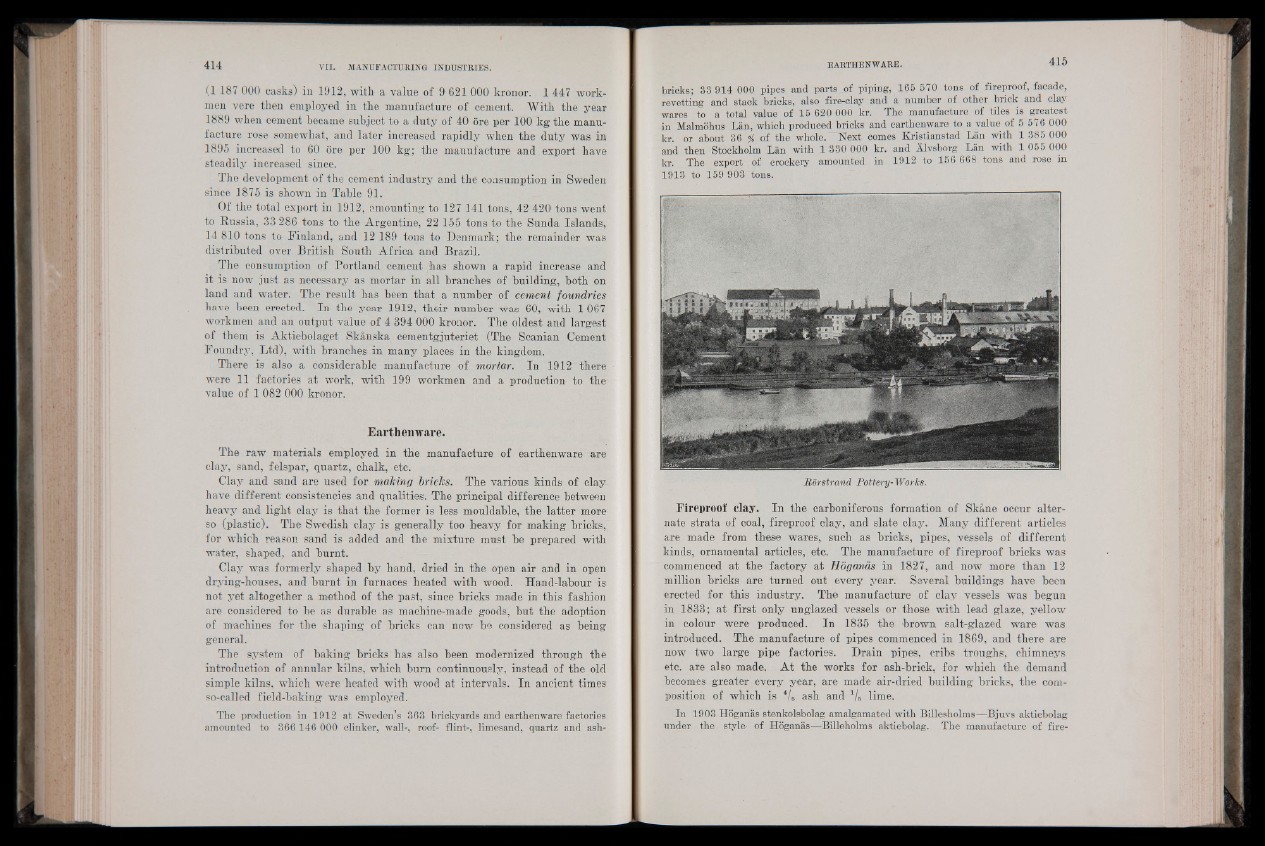
(1 187 000 casks) in 1912, with a value of 9 621 000 kronor. 1 447 workmen
vere then employed in the manufacture of cement. With the year
1889 when cement became subject to a duty of 40 ore per 100 kg the manufacture
rose somewhat, and later increased rapidly when the duty was in
1895 increased to 60 ore per 100 kg; the manufacture and export have
steadily increased since.
The development of the cement industry and the consumption in Sweden
since 1875 is shown in Table 91.
Of the total export in 1912, amounting to 127 141 tons, 42 420 tons went
to Russia, 33 286 tons to the Argentine, 22 155 tons to the Sunda Islands,
14 810 tons to Finland, and 12 189 tons to Denmark; the remainder was
distributed over British South Africa and Brazil.
The consumption of Portland cement has shown a rapid increase and
it is now just as necessary as mortar in all branches of building, both on
land and water. The result has been that a number of cement foundries
have been erected. In the year 1912, their number was 60, with 1 067
workmen and an output value of 4 394 000 kronor. The oldest and largest
of them is Aktiebolaget Skanska cementgjuteriet (The Scanian Cement
Foundry, Ltd), with branches in many places in the kingdom.
There is also a considerable manufacture of mortur. In 1912 there
were 11 factories at work, with 199 workmen and a production to the
value of 1 082 0 0 0 kronor.
Earthenware.
The raw materials employed in the manufacture of earthenware are
clay, sand, felspar, quartz, chalk, etc.
Clay and sand are used for making bricks. The various kinds of clay
have different consistencies and qualities. The principal difference between
heavy and light clay is that the former is less mouldable, the latter more
so (plastic). The Swedish clay is generally too heavy for making bricks,
for which reason sand is added and the mixture must be prepared with
water, shaped, and burnt.
Clay was formerly shaped by hand, dried in the open air and in open
drying-houses, and burnt in furnaces heated with wood. Hand-labour is
not yet altogether a method of the past, since bricks made in this fashion
are considered to be as durable as machine-made goods, but the adoption
of machines for the shaping of bricks can now be considered as being
general.
The system of baking bricks has also been modernized through the
introduction of annular kilns, which burn continuously, instead of the old
simple kilns, which were heated with wood at intervals. In ancient times
so-called field-baking was employed.
The production in 1912 at Sweden’s 363 brickyards and earthenware factories
amounted to 366 146 000 clinker, wall-, roof- flint-, limesand, quartz and ashbricks;
33 914 000 pipes and parts of piping, 165 570 tons of fireproof, facade,
revetting and stack bricks, also fire-clay and a number of other brick and clay
wares to a total value of 15 620 000 kr. The manufacture of tiles is greatest
in Malmôhus Lan, which produced bricks and earthenware to a value of 5 576 000
kr. or about 36 / of the whole. Next comes Kristianstad Lan with 1 385 000
and then Stockholm Lan with 1 330 000 kr. and Âlvsborg Lan with 1 055 000
kr. The export of crockery amounted in 1912 to 156 668 tons and rose in
1913 to 159 903 tons.
Bôrstrand Pottery- Works.
Fireproof clay. In the carboniferous formation of Skane occur alternate
strata of coal, fireproof clay, and slate clay. Many different articles
are made from these wares, such as bricks, pipes, vessels of different
kinds, ornamental articles, etc. The manufacture of fireproof bricks was
commenced at the factory at Hoganas in 1827, and now more than 12
million bricks are turned out every year. Several buildings have been
erected for this industry. The manufacture of clay vessels was begun
in 1833; at first only unglazed vessels or those with lead glaze, yellow
in colour were produced. In 1835 the brown salt-glazed ware was
introduced. The manufacture of pipes commenced in 1869, and there are
now two large pipe factories. Drain pipes, cribs troughs, chimneys
etc. are also made. At the works for ash-brick, for which the demand
becomes greater every year, are made air-dried building bricks, the composition
of which is 4/5 ash and a/5 lime.
In 1903 Hoganas stenkolsbolag amalgamated with Billesholms—Bjuvs aktiebolag
under the style- of Hoganas—Billeholms aktiebolag. The manufacture of fire